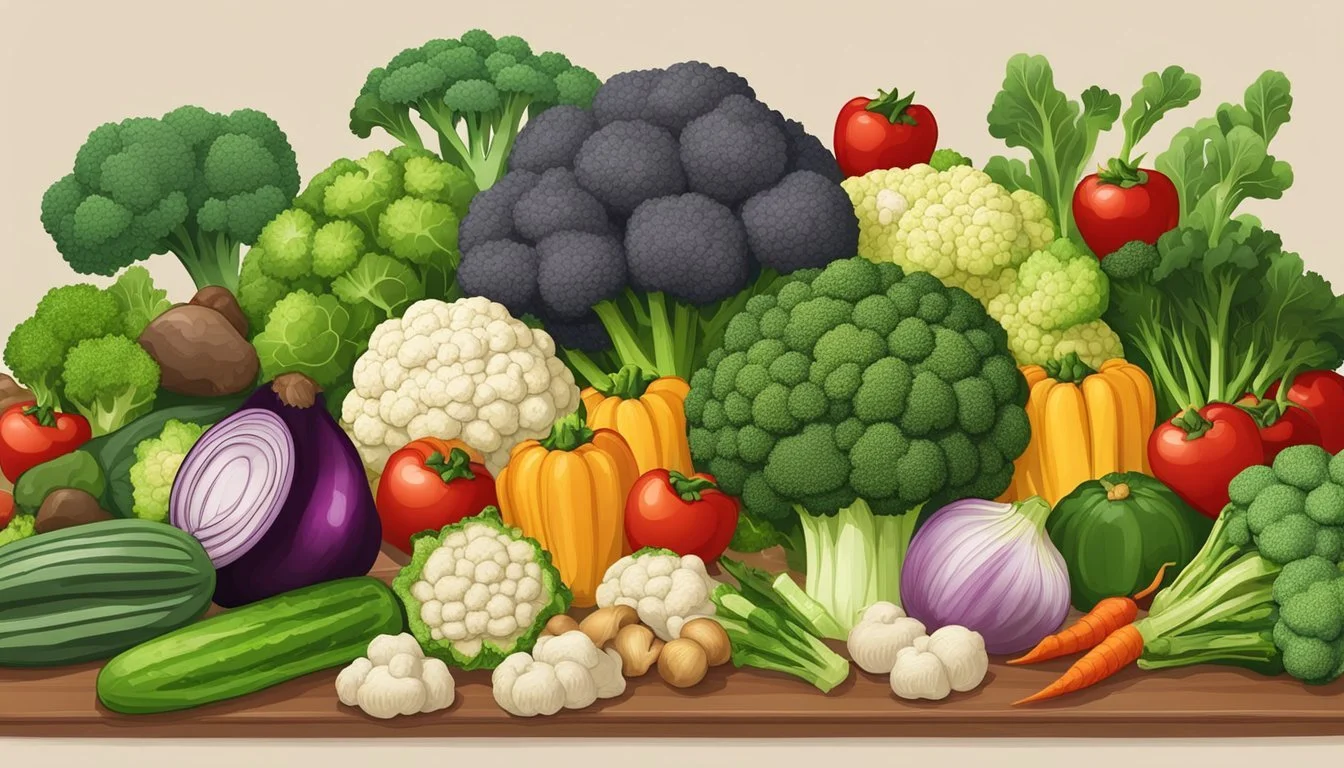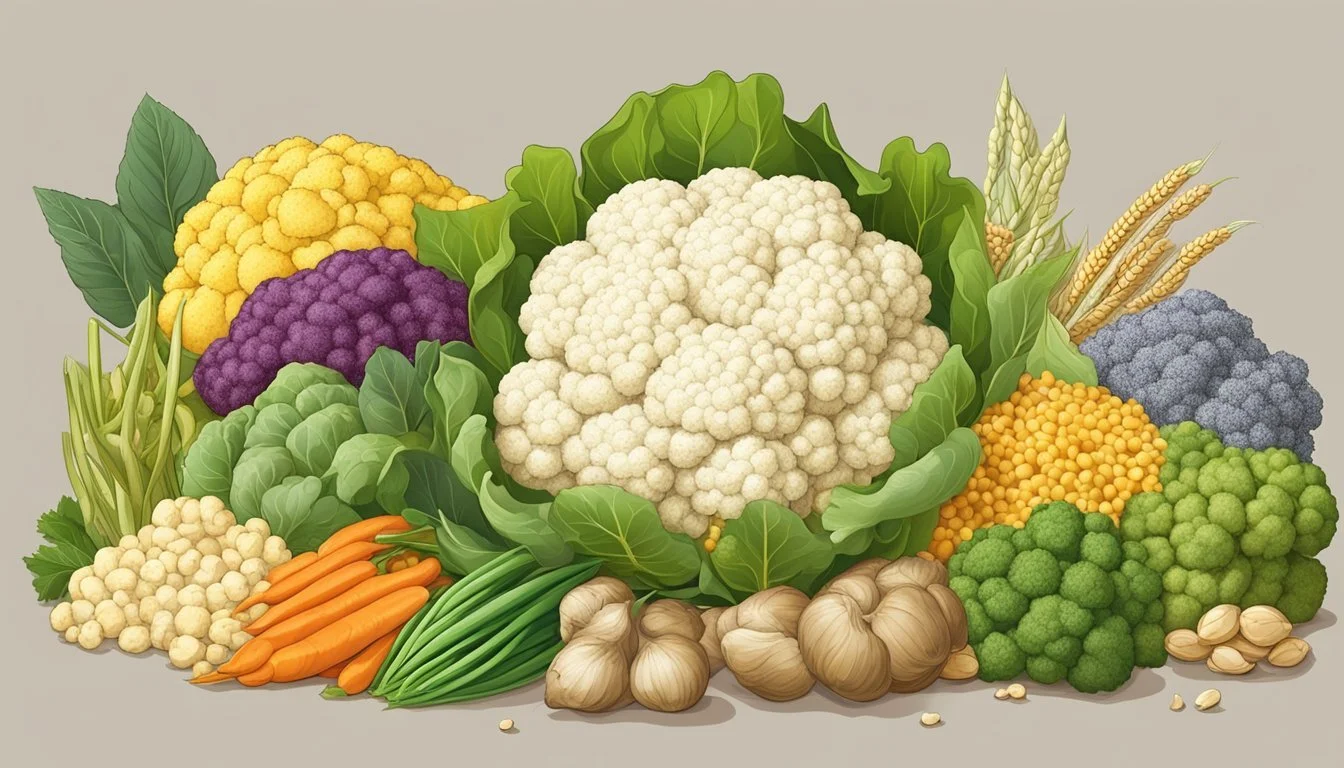Cauliflower Substitutes
Top Alternatives for Low-Carb Diets
Cauliflower has cemented its position as a versatile player in the culinary world, lauded for its ability to blend seamlessly into a myriad of dishes. As a cruciferous vegetable, it's not only a healthy inclusion to any meal but also an excellent choice for those looking to cut down on carbs or grains. However, whether due to taste preferences, dietary restrictions, or simply for variety, one may seek substitutes for cauliflower that still align with nutritional goals and maintain the integrity of the dish they are used in.
A host of vegetables are at the ready to take the place of cauliflower. For instance, broccoli, with its similar texture, can be a near-perfect swap in recipes like baked dishes, soups, and salads. It offers a bold green color as a visual bonus. Meanwhile, for those who favor a different flavor profile or have specific health considerations, options like cabbage, legumes, mushrooms (What wine goes well with mushrooms?), and even root vegetables like potatoes and carrots, provide ample opportunity to diversify one's cooking repertoire. Each substitute comes with its own unique set of benefits, flavors, and textures that can add an exciting twist to familiar recipes.
In the selection of a cauliflower substitute, one must consider how the alternative complements the dish's other ingredients and the final taste profile sought. Cabbage, for example, is particularly favored for making cauliflower rice due to its texture and mild taste, while mushrooms provide a savory depth that enhances the umami in dishes. Beyond mere replacements, these substitutes can also contribute to a more nutritious and colorful plate, reinforcing vegetables’ role in a balanced and health-conscious diet.
Understanding Cauliflower Substitutes
In exploring cauliflower substitutes, it is essential to consider both their nutritional benefits and how they compare in culinary applications to the versatile cauliflower.
Nutritional Profile and Benefits
A key aspect of cauliflower is its high nutritional value, which includes a wealth of vitamins, minerals, and dietary fiber. When seeking substitutes, one should look for alternatives that provide similar health benefits.
Broccoli: Much like cauliflower, broccoli is rich in fiber and contains vitamin C, vitamin K, and a range of minerals. It's an excellent stand-in, nutritionally and texture-wise.
Cabbage: Although slightly different in texture, cabbage is another fibrous vegetable that can mirror cauliflower in recipes, offering a good source of vitamin C and K.
Carrots: While carrots have a firmer texture, they are a good source of fiber, vitamin A, and potassium.
Mushrooms: Known for their protein content, mushrooms are a healthy substitute with fewer carbohydrates, contributing to a savory flavor profile.
One should also consider the protein content; legumes, for example, are a cauliflower substitute that can contribute protein to a dish, although they offer a different texture.
Culinary Uses and Textural Comparisons
Cauliflower is lauded for its versatility in culinary contexts due to its mild flavor and adaptable texture. Substitutes should be able to similarly transform across various cooking methods, such as roasting, steaming, or mashing.
Texture: When substituting in recipes like rice and mash, it's crucial to choose an alternative that can mimic cauliflower's characteristic texture.
Broccoli and Cabbage: Can be riced to mirror cauliflower rice, maintaining a comparable texture.
Legumes: Particularly when mashed, can emulate the texture of cauliflower mash.
Root Vegetables: They often require longer cooking times and come with a firmer texture.
Cooking Methods:
Steaming and Sautéing: Carrots and broccoli are easily interchangeable with cauliflower.
Roasting: Root vegetables such as sweet potato, turnips, and parsnips can replace cauliflower in roasting recipes but keep in mind that they generally have a higher carbohydrate content.
Gluten-free Baking: A mix of riced cauliflower, chia or flaxseeds, and water can serve as an egg substitute, expanding cauliflower's use beyond savory dishes to baked goods.
Vegetable Alternatives
When looking for cauliflower substitutes, several vegetables can serve as equally nutritious and palatable options. They can be categorized into families like cruciferous vegetables, root vegetables, squashes, leafy greens, and legumes, each offering unique textures and flavors.
Broccoli and Cabbage Variants
Broccoli is frequently heralded as the closest vegetable substitute for cauliflower in both flavor and texture. It can seamlessly transition into recipes calling for cauliflower, including rice, pizza crusts, and creamed dishes. Brussels sprouts and other cabbage variants also offer a similar taste, with Brussels sprouts providing a slightly nuttier profile.
Best use for broccoli and cabbage variants:
Steamed
Roasted
In rice forms
Mashed
Root Vegetables and Squashes
Root vegetables such as sweet potatoes (What wine goes well with sweet potatoes?), carrots, and parsnips are fantastic substitutes for cauliflower, particularly in roasted dishes. Their naturally sweet and earthy flavors contribute depth to any dish. Zucchini and squashes, with their mild and slightly sweet taste, are excellent in casseroles (What wine goes well with casseroles?) and as a lower-calorie option in entrees.
Examples of root vegetables and squashes:
Sweet potatoes
Carrots
Parsnips
Zucchini
Leafy Greens and Legumes
Kale and other leafy greens might not mimic cauliflower's texture but are excellent for adding nutritional value and color to dishes. Legumes such as beans and lentils also do not replicate the texture but provide a hearty, protein-rich alternative in soups and stews. Mushrooms, while not a legume, offer a meaty texture and umami flavor that enriches plant-based substitutions.
Incorporation tips for leafy greens and legumes:
Kale can be baked to crispness, adding texture to dishes.
Mushrooms can be sautéed to bring out a rich, savory flavor.
Legumes work best in soups and stews for added thickness.
Grain and Legume Substitutes
When exploring low-carbohydrate and gluten-free alternatives to traditional grains and legumes, cauliflower stands out for its versatility. It’s a nutritional powerhouse capable of mimicking the texture and flavor profile of many staple foods without the high starch content.
Rice and Lentil Variations
For those seeking a substitute for rice or lentils, cauliflower can be processed into small, rice-like grains that are both satisfying and lighter in carbohydrates. This variation, commonly known as cauliflower rice, can fulfill the role of rice in a variety of dishes, including stir-fries, pilafs, and salads. In similar culinary applications, one could use chopped mushrooms for an earthy flavor or asparagus pieces for a slightly sweet undertone.
Legumes, particularly lentils, are often a staple in plant-based diets due to their high protein content. To create a comparable texture with fewer carbs, individuals may consider options such as:
Edamame: A young soybean offering a soft yet slightly crunchy texture.
Chopped nuts: For a bit of crunch and a nutty flavor.
Chickpeas and Peas
Chickpeas and peas are popular ingredients in spreads and soups. Replacing chickpeas, for example in hummus, can be achieved using cooked and pureed cauliflower to produce a creamy and smooth texture. Low-carb alternatives also include zucchini and macadamia nuts, which yield a delightful consistency in spreads.
For dishes that typically feature peas as a primary component, such as soups and salads, cauliflower offers a similar mouthfeel and is a fruitful substitute, especially when aiming to reduce the dish's overall glycemic index.
Meat Substitutes
When one seeks to replace meat in their diet, they often look for alternatives that provide protein and can mimic the texture and flavor of meat. Two popular plant-based options are tofu and tempeh, which not only serve as protein sources but can also take on a variety of flavors.
Tofu and Tempeh
Tofu, derived from soybeans, is a versatile protein-rich substitute that can be used in a myriad of dishes. It comes in varying levels of firmness, with silken tofu being ideal for smoothies and desserts, and firm or extra-firm tofu suitable for stir-fries and grilling. One can marinate tofu to enhance its flavor, as it adeptly absorbs spices and seasonings.
Protein Content: Approximately 8 grams per 3.5 ounces (100 grams)
Tempeh is a whole soybean product with a distinct nutty taste and a substantial, meaty texture. It's an excellent meat substitute as it's high in protein and can be sliced, crumbled, or chopped to use in various recipes such as stir-fries, salads, and sandwiches.
Protein Content: Approximately 19 grams per 3.5 ounces (100 grams)
Other Protein-Rich Substitutes
Legumes such as lentils, beans, and chickpeas can effectively replace meat due to their high protein content. They work well in recipes like soups, stews, and patties.
Example: Black beans can be mashed for burgers with about 15 grams of protein per cup.
Nuts and seeds provide both protein and healthy fats. They can be added to salads, pasta, or used to make nut-based "meat" like almond meal meatballs.
Example: Almonds contain about 6 grams of protein per ounce.
Grains such as quinoa or buckwheat also offer protein and are excellent meat substitutes in pilafs, salads, or as a side dish.
Example: Quinoa contains roughly 8 grams of protein per cup when cooked.
Cauliflower-Based Preparations
Cauliflower has gained popularity as an adaptable substitute in a variety of dishes where it mimics the texture and function of other ingredients with fewer carbohydrates.
Cauliflower Rice and Mash
Cauliflower rice is a staple substitute for traditional grains and is made by pulsing cauliflower florets in a food processor until they resemble the size and texture of rice grains. This preparation can serve as a low-carb alternative in meals that typically include rice, such as stir-fries or as a side dish. To enhance the taste, it can be sautéed with garlic, herbs, and a touch of olive oil.
For a comforting side, cauliflower mash replaces potatoes with steamed or boiled cauliflower florets that are then blended with ingredients like butter, cream, and seasoning until smooth. This mash captures the creamy texture of traditional mashed potatoes while providing a milder, subtly sweet cauliflower taste.
Cauliflower Pizza Crust and Mac and Cheese
Cauliflower Pizza Crust: This gluten-free alternative starts with a base of steamed cauliflower florets which are finely riced and then combined with binding agents such as eggs and cheese. The mixture is formed into a crust shape and baked until golden and crispy, providing a sturdy foundation for all the favorite pizza toppings.
Ingredients: Steamed cauliflower rice, eggs, cheese, and seasonings.
Cooking method: Press into a crust form, pre-bake to firm up, add toppings, and bake again.
Cauliflower Mac and Cheese: Cauliflower steps in for pasta in this low-carb version of mac and cheese. The florets are boiled or steamed until tender, then mixed with a rich cheese sauce that balances the mild taste of cauliflower with a deep cheese flavor. It can be served as is, or baked further for a crispy topping.
Ingredients: Cauliflower florets, cheese sauce (cheese, milk, butter, seasoning).
Preparation: Combine cauliflower with sauce and bake for a bubbly, golden crust.
Cooking Techniques for Substitutes
Preparing vegetable substitutes for cauliflower can change the flavor and texture profile of dishes while offering nutritional variety. The following subsections detail various methods to cook these substitutes effectively.
Roasting and Grilling
Roasting enhances the natural sweetness of vegetables like broccoli, carrots, and mushrooms. These substitutes should be cut into uniform pieces to ensure even cooking. Toss them lightly in oil, season as desired, and spread them out on a baking sheet. Broccoli and carrots are best roasted at a high temperature (around 425°F) until they're tender and have a slight char, typically 20-30 minutes. Mushrooms can be grilled for a smoky, savory flavor — just thread them on skewers or place them on a grill mat to prevent sticking and grill on medium-high heat until cooked through.
Boiling and Steaming
Boiling and steaming provide gentle cooking methods suitable for legumes and asparagus. These methods can maintain a good amount of moisture and tenderness. For instance, legumes should be boiled until they are soft enough to blend into a mash, following package recommendations for time. On the other hand, asparagus benefits from steaming to preserve its texture and slight sweetness, often taking between 3-5 minutes depending on the thickness of the stalks.
Frying and Sautéing
Quick methods like frying and sautéing suit vegetables that cook rapidly and benefit from a crispy exterior. Cabbage can be sliced and sautéed to mimic cauliflower rice, achieving tenderness while still offering a bit of crunch. To do so, one can stir-fry cabbage on high heat for a few minutes with a dash of oil. Mushrooms also respond well to sautéing; they should be cooked on medium-high heat until browned and their moisture has evaporated, bringing out a concentrated, meaty flavor.
Seasonal and Flavor Considerations
When selecting a cauliflower substitute, it is crucial to match the vegetable's seasonal availability with the desired flavor profile: sweet and earthy or nutty and mild.
Sweet and Earthy Flavors
For those who prefer a sweet and earthy flavor similar to cauliflower, they might consider root vegetables. Carrots, for instance, offer a subtly sweet taste and can be found in most seasons. They work well in a roast, steamed, or sautéed form.
Beets: Offer deep, earthy sweetness; ideal in cooler seasons.
Sweet potatoes: Provide a hearty, sweet flavor suited for fall and winter dishes.
Nutty and Mild Flavors
Some prefer the nutty and mild flavor that complements dishes without overpowering them. Broccoli stands out as the best year-round substitute for its mild, slightly sweet flavor profile and similar texture to cauliflower.
Zucchini: Available in the summer, offers a nutty hint when cooked.
Asparagus: Spring vegetable with a subtly nutty taste, works well steamed or grilled.
Enhancing Dishes with Substitutes
Cauliflower, versatile and neutrally flavored, is often used to replace denser carbs in various dishes, but other substitutes can also enhance the taste and texture of meals.Bulking Up Salads and Soups
Salads gain substance and richness with the addition of alternatives to cauliflower, such as broccoli, which brings a slight bitterness and crunch. One can also incorporate roasted root vegetables, like sweet potatoes or beets, to introduce earthy flavors and a satisfying chew. For creamed soups, a puree of root vegetables can add both body and a creamy consistency without overpowering the intended flavor profile.
Salads:
Broccoli — adds crunch and a hint of bitterness.
Roasted vegetables (e.g., sweet potatoes, beets) — provide earthiness and chew.
Creamed Soups:
Root vegetable puree — contributes creaminess and body without a strong cauliflower taste.
Creating Hearty Stir-Fries and Casseroles
Stir-fries and casseroles benefit from substitutes that maintain structural integrity under heat. Chickpeas can be a protein-rich addition, adding both heft and a pleasant textural contrast. For those seeking a low-carb option akin to rice, alternatives like zucchini noodles (zoodles) or squash can serve as an excellent base, absorbing flavors while providing bulk. When aiming to minimize the cauliflower taste, the use of these alternatives can also mask or complement the overall flavor of the dish.
Stir-Fries:
Chickpeas — offer protein and a satisfying bite.
Zoodles/squash — act as a flavorful, low-carb base.
Casseroles:
Squash/potato mash — for a hearty and dense texture.
Grated vegetables (e.g., rutabaga or potatoes) — to reduce cauliflower flavor and increase bulk.
Health Considerations and Dietary Choices
When considering cauliflower substitutes, it's important for individuals to be mindful of their dietary needs and health goals. Substitutes may vary widely in their nutritional content and compatibility with certain diets.
Low-Carb and Gluten-Free Diets
For those adhering to low-carb or gluten-free diets, vegetables such as cabbage and mushrooms serve as excellent cauliflower substitutes. These vegetables are low in carbohydrates and naturally gluten-free, making them suitable for individuals aiming to reduce their carb intake or those with gluten sensitivities.
Cabbage: A versatile vegetable that can mimic cauliflower rice, providing essential dietary fiber while maintaining a low-carb profile.
Mushrooms: With a savory flavor profile, mushrooms can replace cauliflower in dishes and are also low in carbs.
Gluten-free options also include broccoli and asparagus, which can replace cauliflower in recipes and still maintain the dietary restrictions of individuals.
Vegan and Vegetarian Options
Vegans and vegetarians often look for substitutes that align with their plant-based lifestyle while also providing necessary nutritional benefits.
Legumes: Packed with protein and fiber, legumes can be mashed to resemble the texture of cauliflower and fit well in a vegan or vegetarian diet.
Potatoes: Although not low-carb, potatoes are a hearty alternative offering vital vitamin C and potassium, and can be creatively used in vegetarian dishes (What wine goes well with vegetarian dishes?) as a stand-in for cauliflower.
It is crucial for those following vegan or vegetarian diets to ensure that their vegetable intake includes options that provide ample dietary fiber and other essential nutrients typically found in cauliflower.





